Total joint replacements in hip and knee ankylosed in gross flexion: A case report
Received: 05-May-2017 Accepted Date: May 31, 2017 ; Published: 02-Jun-2017
This open-access article is distributed under the terms of the Creative Commons Attribution Non-Commercial License (CC BY-NC) (http://creativecommons.org/licenses/by-nc/4.0/), which permits reuse, distribution and reproduction of the article, provided that the original work is properly cited and the reuse is restricted to noncommercial purposes. For commercial reuse, contact reprints@pulsus.com
Abstract
Total knee and hip replacement have been very successful surgeries and the indications for these are extending daily. We are presenting the case of an adult female who was crippled due to severe deformity of her hip and knee joints and had her life improved tremendously after the surgery. However, the post-operative range of flexion and hip stability were not as good as those following primary hip replacement in joints that had not been ankylosed. Nevertheless, with proper planning and meticulous surgery, it is possible to provide stable and mobile joints to the patients and make their life way better. We suggest that all such patients should be given the option of replacement and few anticipated complications and outcome somewhat inferior to non-ankylosed joints, should not deprive them of the opportunity to make their lives self-reliant.
Keywords
Total hip arthroplasty; Total knee Arthroplasty; Bony ankylosis; Severe flexion; Deformity
Introduction
Total knee and hip replacement have been very successful surgeries and the indications for these are extending daily. Earlier, joint replacement surgery was seen as a salvage procedure and was offered to old and crippled patients, leaving the young patients wait in agony and waste the most productive years of their lives. The predictable and satisfactory outcome has led to its use not just for painful joint but even for a painless deformed joint. We are presenting the case of an adult female who was crippled due to severe deformity of her hip and knee joints and had her life improved tremendously after the surgery. Proper informed consent was taken from the patient for publication of the data.
Case Report
The patient is a 38-year-old lady who was diagnosed with juvenile idiopathic arthritis at the age of 13 years but did not take proper treatment and ended up being wheelchair bound. Her disability progressed gradually over the 25 years and on presentation to us, she had serious functional limitation and poor personal hygiene. Because of the deformity and stiffness of all major joints of lower limb, her ambulation was limited to crawling and in bed mobilization, severely jeopardizing her social life. Her upper limb joints were less severely affected.
On clinical examination, her general condition was average. Both the hips were fixed in around 90 degrees of flexion and external rotation with right hip fixed in adduction and left hip in abduction. Also, the knees were fixed in 110 degrees of flexion with no movement possible and her ankles and feet were also deformed (Figure. 1). She had Z deformity of both her hands but her shoulder, elbows and spine were relatively normal. Muscles of upper and lower limbs appeared wasted with quadriceps atrophy being most prominent. Skin was atrophic and stretched out, especially over the joints. She was not on any medication currently but had history of steroid intake for long.
Further investigations included blood workup including inflammatory markers ESR and CRP which were normal, suggesting inactivity of the disease. Radiographs of the knee and hip joints showed bony ankylosis (Figures. 2-4) with arthritis of ankle, wrist and shoulder joints and generalized osteopenia. As a part of pre-anaesthetic checkup chest x-ray and echocardiogram were done and found to be normal.
Patient had come to us with expectations of having painless, mobile joints and ability to ambulate without support. As multiple joints were ankylosed in unacceptable position, arthrodesis or girdlestone arthroplasty were not options. We gave her the option of total hip and total knee replacement but warned her about possible complications in this unique case. Patient was hopeless and was convinced that her condition could not get any worse so much so that she was ready to take the risk.
Because knee surgery requires deep flexion at hip, we decided to replace hips first. Patient was given general anesthesia, put in lateral position, and operated using posterior approach. Because head was not dislocatable, in situ neck osteotomy had to be done and then acetabulum was reamed through the ankylosed head taking care of the acetabular walls and positioning. Extensive soft tissue releases were required to correct the deformities and a primary non-constrained uncemented implant was used (Stryker). (Figure. 5) Owing to the osteoporotic bone, there was undisplaced spiral fracture of right proximal femur which was taken care of using cerclage wires. Adductor tenotomy was done postoperatively as the tendons standout only after taking down the ankylosis. Though considerable correction of deformity was obtained on table, hip was kept in flexion initially so as to prevent any neurovascular complication. It was only after ensuring an adequate neuro vascular status, that gradual stretching of the joints was done. Patient was encouraged to do hip abduction and flexion exercises, very next day after the surgery. She was also kept in prone position to further correct the hip flexion. Though she was allowed to turn in bed and sit by the side of the bed, she could not stand because of the acute knee flexion.
After 2 weeks, her condition was reassessed and it was decided to operate both the knees in the same sitting. Patient was given general anesthesia and left knee was operated first, under tourniquet. Medial parapatellar approach was used (Figure. 8), patella was found fused to the underlying femur condyles and was mobilized using sharp osteotomes taking care not to damage the condyles. Synovectomy was done, lateral and medial gutters were cleared and quadriceps was mobilized too, but patella could not be everted. Knee joint line was identified by the horizontal depression between femur and tibia and was carefully osteotomized using saw removing a wedge of bone (Figure. 9). Further soft tissue release was done from posterior aspect of tibia and femur so that the tibia could be subluxated enough to take 8mm proximal tibial cut perpendicular to its mechanical axis and keeping the posterior slope to minimum. To create some extension space, 4mm thicker distal femur cut was taken and posterior capsule was lifted off the femur. After taking other cuts in proper orientation, trial was done which revealed varus-valgus instability and around 60 degrees of persistent flexion deformity. So, additional distal femur cut had to be taken and a constrained knee implant (Total stabilizing, Stryker) was used. (Figures. 6 and 7) After final implantation, there was no instability but 30 degrees of flexion deformity persisted. Similarly, right knee was operated but instead of a constrained system, use of just a constrained liner and tibial stem gave satisfactory stability. Both the knees were closed in layers, suction drain was put and occlusive dressing done. To ensure good patellar tracking, patelloplasty and lateral retinacular release was done. We applied above knee casts on both sides with aim to gradually correct the flexion deformity by serial wedging. Patient was mobilized using walker on the day after surgery and was instructed to do Q-drill with the cast applied. After 2 weeks, flexion deformity left was around 5 degrees and so the cast was removed. So, 4 weeks after the first surgery, she was allowed to do range of motion exercises using CPM machine, Q-drill and Straight leg raising. On the left side, she developed necrosis of the skin which healed in one week. Physiotherapy was regularly monitored by us and gait training was also given. At around 3 months, she was able to walk unassisted and was able to do most of her daily activities.
On the final follow up at 2 years, she had no flexion deformity or extension lag at the knees and was able to move around independently. (Figure. 10) Her preoperative Hospital for Special Surgery Knee Score of 54 points improved to 88. The arc of motion was 0 to 120 degrees of flexion at knee and 0 to 120 degrees of flexion with around 30 degrees of abduction and adduction each at the hip joint. She was able to climb stairs and perform her daily activities independently.
Discussion
A young patient with deformed major joints of the body does not suffer just physically but mentally as well. Often, the devastating effects of inflammatory arthritis are spontaneous and not necessarily due to neglect. It is important for a physician to recognise the disease early and more important for the patient to continue the treatment properly which is often life-long and appears to be ineffective. It is proven beyond doubt that earlier the medical treatment is started, the less joint damage is likely to occur, which in turn obviates or defers a major surgery. [1] Some patients will have joint destruction despite adequate treatment and ultimately, they need surgery. Even such patients will have better surgical outcome if operated at right time rather than at an advanced stage when the surgery is challenging and results are poorer. Theoretically, deformed joints can be treated with osteotomy and soft-tissue release, arthrodesis in an optimal position and arthroplasty. But, the results of arthroplasty are more predictable and satisfactory compared to other options of treatment and it may be the only treatment option in cases where all 4 major joints of lower limb are involved.
Most of the authors have described their experiences in dealing with either ankylosed knee or ankylosed hip and a few authors who have replaced all 4 joints, have done it over months. It is common to replace joints in fibrous ankylosis which is technically easier, as the joint can be dislocated and the rest of the surgery proceeds as usual. Replacement of joints fixed in extension or slight flexion have lesser at stake compared to joints fixed in gross flexion especially in terms of neurovascular complications. Very few surgeons viz Kim et al. [2] have reported their results with replacement in bony ankylosis and severe flexion. Our case is unique because we replaced 4 joints fixed in gross flexion, successfully within a span of 2 weeks and the patient was able to walk within 4 weeks after being bedridden for 25 years.
Various authors have described different methods of total knee replacement in patients with knees ankylosed in severe flexion. In two-staged arthroplasty of flexed knees, first stage involves taking down the bony fusion and soft-tissue releases, followed by distal tibial skeletal traction to maximally correct flexion deformity, after which TKA can be done [2]. Our experience with 2-stage arthroplasty has not been encouraging as the impinging bone ends do not let flexion deformity correct and second stage behaves like revision surgery. The use of skeletal traction is always fraught with the risk of infection and our experience with post replacement skeletal traction is also unfavourable. We used cylinder cast with serial wedging to correct the residual flexion of 30 degrees which got fully corrected in 2 weeks.
Of utmost importance is preoperative planning in such cases so that the inventory is not a limitation. Because knees are hypoplastic from the long duration of adolescent disease, small components are often required. Also, the soft tissue envelope around the joint are often weakened in such long standing cases which may necessitate the use of constrained prosthesis. The osteoporotic bone may be easily damaged while taking down the fusion and large bone defects can be created, which may need metal augments and stem extenders. Hence, we need to be prepared with all sorts of constrained prosthesis including a rotating hinge prosthesis.
It is challenging and requires experience for conversion procedure for ankylosed hips, especially positioning of the prosthesis. Tang et al. [3] hypothesized that pelvic malrotation in the sagittal plane, which is common in chronic and bilateral hip conditions, can cause errors in cup positioning. They suggested a deviation from normal 45° inclination and 15-20° ante version of the cup so that, for each 10° of sagittal pelvic malrotation >20°, the cup needs to be positioned so that it is 5° less inclined and anteverted so as to minimize the risk of anterior dislocation.
Before placing the implants, it is important to get a good exposure and to identify the location of the original joint plane. Special care should be taken of sciatic nerve which comes within the surgical field and is prone to injury in case of externally rotated femur. Even in hips with bony fusion, there always remained incomplete gray ossifying cartilage at the location of the original joint plane, which is a guide to the limit of medialisation of the cup [4]. Bony osteoporosis necessitates under reaming of acetabular cup with or without impaction grafting and precludes the use of force while preparing femur. Though some authors suggest the use of distal fitting stems, we did not find any indication to put in a revision implant in a young patient. [5].
Kim et al. [2] performed total knee arthroplasty on 27 knees in 24 patients with spontaneous bony ankylosis in severe flexion (mean position 105° flexion). The preoperative HSS Knee Score of 60 points was improved to 87 at the final follow-up three to five years later. The mean fixed flexion deformity was 6° (0 to 25) and the extension lag 8° (0 to 25). They used sub-vastus approach and extensive soft tissue release including heads of gastrocnemius muscle. One patient had a rupture of the quadriceps tendon. They performed one-stage TKA and skeletal traction after operation to achieve correction of residual flexion deformity of the knee of about 45 degrees. Rajgopal et al. [6] presented a series of 84 knees among 53 patients with severe joint limitation. They used various extensile approaches and after a mean follow-up of 9 years, they considered their results to be good with average extensor lag of 6 degrees and flexion deformity of less than 5 degrees.
Karva et al. [7] reported the case of a 25-year-old patient with juvenile rheumatoid arthritis and ankylosis of both hips and both knees treated by staged bilateral hip and knee arthroplasty over 6 months. At 18 months follow up, the ranges of movement achieved at the hip and knee were comparable to those reported in the literature.
Finally, we should be aware of common complications in such cases so that we can be careful. Skin edge necrosis and resultant delayed wound healing is a very common complication and even we encountered this problem in left knee wound but infection did not develop due to timely interval. Damage to neurovascular structures is a disastrous complication and can happen intraoperatively while releasing soft tissues in severe flexion at hip or knee, as well as postoperatively due to overstretching. It is advisable not to immediately correct the flexion at hip or knee to normal and gradual correction using plaster wedging can prevent complications like gangrene and foot drop.
Rates of complications in such cases also vary across various studies. Naranja et al. [8]. reported a high complication rate of 57% (including 24% short-term complications, 35% major complications and a 14% infection rate. Bhan et al. [9] reported satisfactory results in 26 total knee arthroplasties for ankylosed knees using four posterior-stabilized implants and 22 condylar constrained prostheses with major complications in four of the 26 knees.
Conclusion
The functional outcome after THA for hip ankylosis and after TKA after knee ankylosis, has been reported to be encouraging. [10]. However the post-operative range of flexion and hip stability were not as good as those following primary hip replacement in joints that had not been ankylosed. [11] Nevertheless, with proper planning and meticulous surgery, it is possible to provide stable and mobile joints to the patients and make their life way better. We suggest that all such patients should be given the option of replacement and few anticipated complications and outcome somewhat inferior to non-ankylosed joints, should not deprive them of the opportunity to make their lives self-reliant.
REFERENCES
- Lard LR., Visser H., Speyer I., et al.: Early versus delayed treatment in patients with recent-onset rheumatoid arthritis: comparison of two cohorts who received different treatment strategies. Am J Med. 2001; 111: 446-451.
- Kim Y.H., Cho S.H., Kim J.S.: Total knee arthroplasty in bony ankylosis in gross flexionJ Bone Joint Surg Br. 1999; 81(2): 296-300.
- Tang W.M., Chiu K.Y., Kwan M.F., et al.: Sagittal pelvic mal-rotation and positioning of the acetabular component in total hip arthroplasty: three-dimensional computer model analysis. J Orthop Res. 2007; 25: 766-771.
- He B., Peijian T., Ju L.: Bilateral synchronous total hip arthroplasty for ankylosed hips. International Orthopaedics. 2012; 36: 697-701.
- Mertl P., Philippot R., Rosset P., et al.: Distal locking stem for revision femoral loosening and peri-prosthetic fractures. IntOrthop. 2011; 35: 275-282.
- Rajgopal A., Ahuja N., Dolai B.: Total knee arthroplasty in stiff and ankylosed knees. J Arthroplasty. 2005; 20: 585-590.
- Karva A.R., Board T.N., Porter M.L.: Conversion of bilateral hip and knee ankylosis to total joint replacements. Bone & Joint Journal. 2008; 90-B(5): 668-673.
- Naranja R.J., Lotke P.A., Pagnano M.W., et al.: Total knee Arthroplasty in a previously ankylosed and arthrodesed knee. ClinOrthopRelat Res. 1996; 331: 234-237.
- Bhan S., Malhotra R., Kiran EK.: Comparison of total knee arthroplasty in stiff and ankylosed knees. ClinOrthopRelat Res. 2006; 451: 87-95.
- Hamadouche M., Kerboull L., Meunier A., et al.: Total hip arthroplasty for the treatment of ankylosed hips: a five to twenty-one-year follow-up study. JBone Joint Surg [Am]. 2001; 83-A: 992-998.
- Amstutz H.C., Sakai D.N.: Total joint replacement for ankylosed hips: indications, technique, and preliminary results. J Bone Joint Surg [Am]. 1975; 57-A: 619-625.

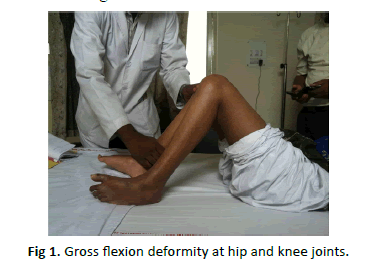
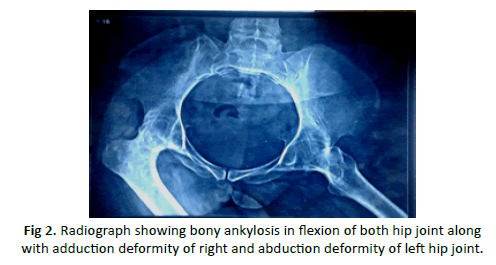
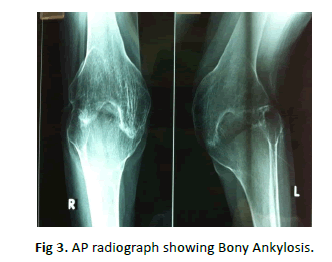
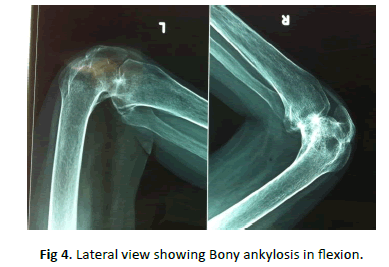
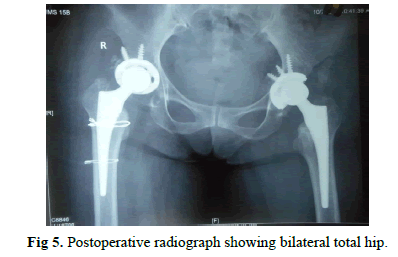
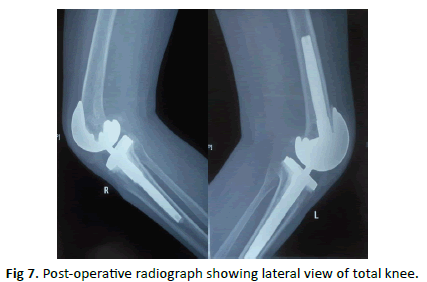
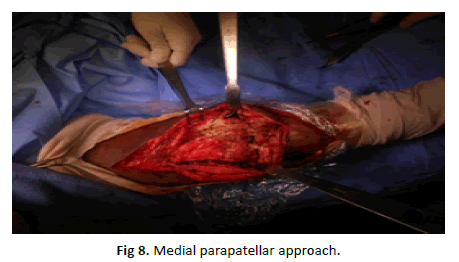
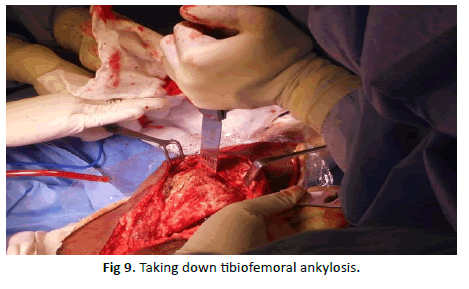
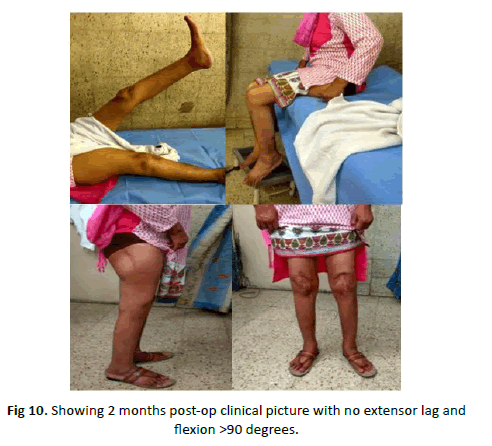
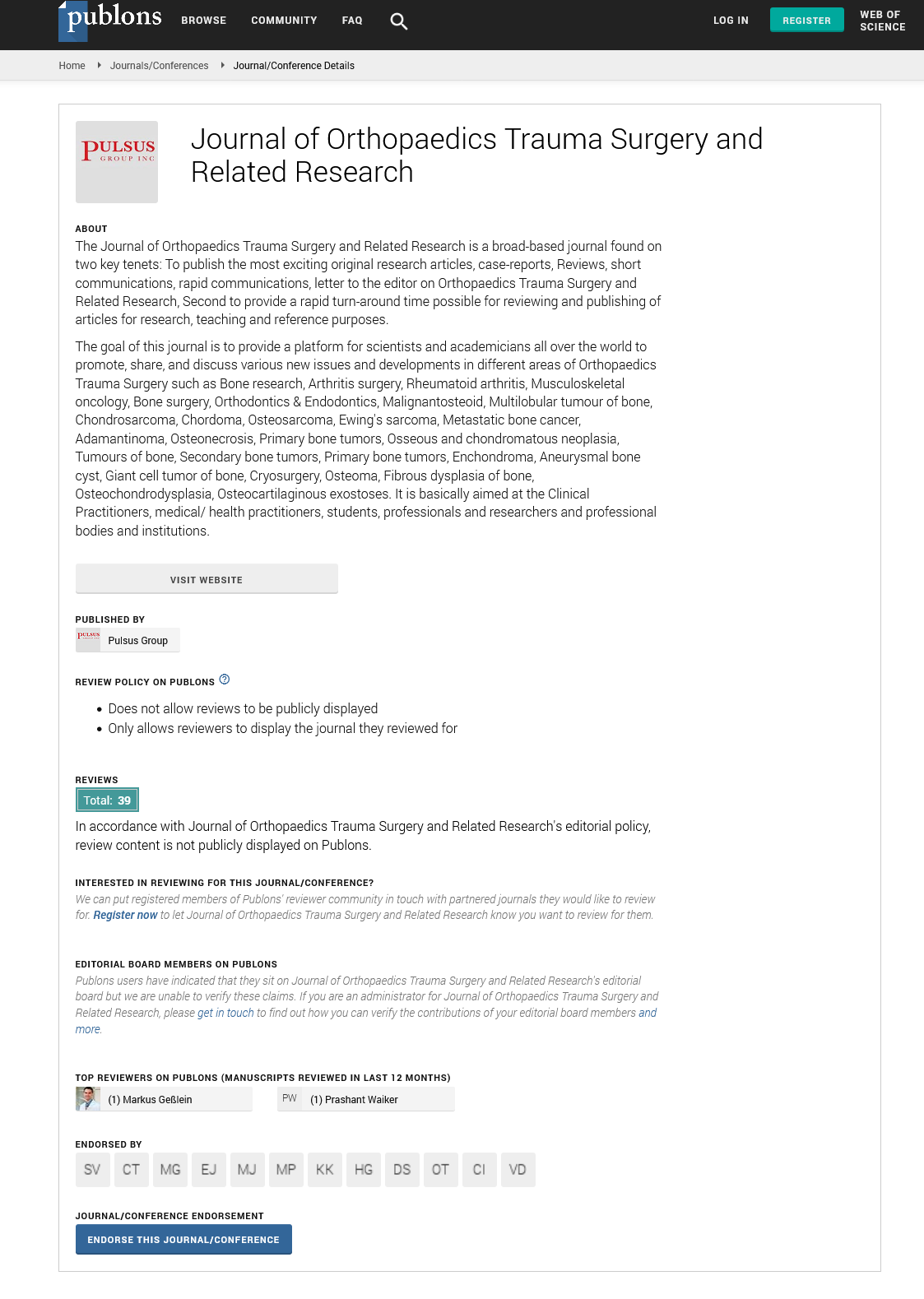
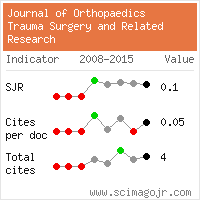
 Journal of Orthopaedics Trauma Surgery and Related Research a publication of Polish Society, is a peer-reviewed online journal with quaterly print on demand compilation of issues published.
Journal of Orthopaedics Trauma Surgery and Related Research a publication of Polish Society, is a peer-reviewed online journal with quaterly print on demand compilation of issues published.